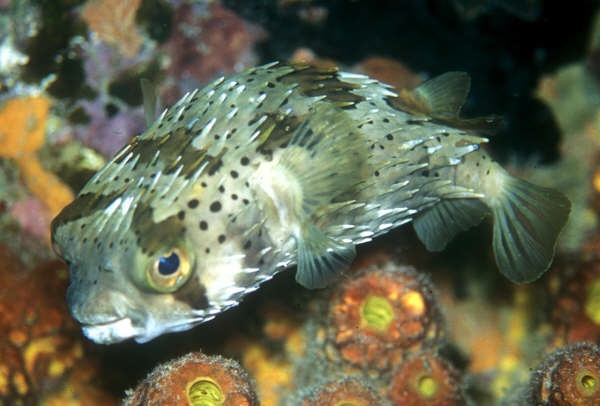 |
|
  |
A Saltwater Puffer Primer: Big Pufferfish! by Mike Maddox ( click images for full size picture ) Marine puffers are fun, cute, interactive, yes, but they’re also big: all the true puffers in the marine aquarium trade attain at least 12 inches (30 cm) in length! Take into account their active nature, and messy feeding habits, and you have yourself a handful. Your first task is finding a tank big enough for one of these prodigious eating machines, and then you’ll need a filter beefy enough for the job, so that you can maintain the good water quality these fish need. Although essentially hardy, like most marine fish, they will not tolerate measurable levels of ammonia and nitrite for extended periods, or nitrates higher than around 30 mg/l. Maintaining good water quality in a pufferfish aquarium is often easier said that done: you’re going to need a big tank with a big filter! An aquarium with a capacity of 125 gallons (475 liters) is really the minimum size for any Arothron or Diodon species, and you’ll need an even bigger tank for some of the rarer, but beautiful, giants like the Map Puffer, Arothron mappa. Obviously, the larger the aquarium, the better, and I house my Map Puffer and Dogface Puffer in a 225-gallon (850-liter) system. Though sold at appealing small sizes, don’t underestimate how quickly, and how big, a fish like Arothron mappa can grow! Now that you have the aquarium, you’ll need a filtration system! An oversized protein skimmer is just as important here as a high capacity biological filter, because puffers will produce a lot of waste. There are many efficient protein skimmers available on the market today, and I recommend purchasing a protein skimmer that’s one size larger than the what would otherwise be rated as acceptable for an aquarium of the size you are using. Don’t forget the most important aspect to keeping your water quality in tip-top shape: water changes! Weekly or even twice weekly water changes of at least twenty-five percent are highly recommended. When doing large water changes, do ensure the temperature, pH, and salinity values of the freshly mixed water match those of your aquarium water. Choosing a healthy puffer When considering a puffer in a pet store, look for one that seems alert, with clear eyes, a slightly rounded stomach, and no signs of disease. Signs of disease can include small white spots, open sores, or fin rot, cloudy or opaque eyes, and an emaciated look. Spotting a healthy pufferfish isn’t difficult: like this Arothron nigropunctatus specimen, they should be alert, active, and definitely interested in the world around them. [Editorial note: Several species of Arothron occur in fresh or brackish water in the wild, usually when very young. Such fish sometimes end up in the freshwater fish trade, most commonly Arothron hispidus. While they often look a bit off-colour when kept in completely freshwater conditions, they are astonishingly hardy, and once acclimated to strongly brackish or fully marine conditions they quickly pep up. As with any euryhaline fish, it doesn’t take long to adjust them from freshwater to brackish or saltwater conditions; an hour spent using the drip method should do the trick nicely.] Feeding Proper feeding of your puffer is essential to its longevity and overall well-being. In order to feed your puffer properly, it helps to have some information on how puffers feed in the wild. Pufferfish are opportunistic predators, hovering over rock shelves searching for snails, and other invertebrates, or actively searching the sea floor for buried crustaceans. Because their prey is usually encased in a shell, puffer teeth never stop growing, so that the are constantly hard and sharp enough to crack or slice open their prey. In the wild, day-to-day abrasion keeps the teeth from getting too long, but in aquaria their teeth can become overgrown if not properly worn down by a suitably crunchy diet. With these facts in mind, your puffer should be fed a diet based largely on tough-shelled invertebrate foods. Fresh, meaty seafood in the shell such as shrimp, crab legs, oysters, mussels, crayfish are ideal daily staples. Commercial frozen diets should be offered a few times a week, and freeze-dried foods (krill, plankton, and prepared carnivore foods) once or twice a week. Provide puffers such as this Arothron hispidus with hard, crunchy foods that simulate their diet in the wild. Wild puffers consume algae of various types as well, either directly, biting at chunks of coralline algae for example, or else via the gut contents of their prey. It is known that the toxins in pufferfish are not synthesized directly by the puffer by taken, second-hand, from these algae. It is a good idea to offer your algae some green foods alongside its usual meaty diet. Some frozen foods will have spinach or algae already included in the mix, but otherwise offer algae wafers, nori, and so on. Many puffers die in captivity from improper diets, and although this can take a few years, they will surely die if they are not fed a variety of foods. The emphasis should be on fresh (or at least good quality frozen) seafood. Offering a variety of foods is critical: some types of seafood such as mussels and prawns can be very high in thiaminase, so these will need to be balanced with seafood that doesn’t contain thiaminase, such as cockles and squid. For more on thiaminase and the problems it can cause, see Conscientious Aquarist Volume 6, issue 1. Feed your puffer enough food to give it a rounded belly once a day, five to six days a week. I suggest that you skip feeding a day or two a week to prevent stomach blockage and potential liver problems. As a final note, do not feed your puffer freshwater feeder fish, ever! Freshwater feeder fish are a completely inappropriate food source for any marine animal, and can cause intestinal blockage leading to the demise of your puffer. Selecting tankmates Once your system is ready (and it will be quite a system, once you’re adequately prepared for long-term pufferfish care) you’ll probably want to consider tankmates. Given that shrimps, clams and most other invertebrates are simply food as far as a pufferfish is concerned, the aquarium will inevitably be of the fish-only type. But you’ll also need to restrict your selection of fish to species robust enough to live successfully with something as boisterous and curious as a pufferfish. Angelfish, tangs, wrasses, triggerfish, damselfish, and clownfish can all make good potential tankmates, although the temperament of your particular puffer will determine precise tankmate compatibility to some degree. Housing other fish with puffers may be challenging, but likely your puffer will be the star of the show anyway! Puffers are boisterous and inquisitive, so tankmates should be chosen carefully; this Arothron nigropunctatus will get along best with angelfish, surgeonfish and other robust species. Pufferfish Species Now it’s time to take your newfound education and decide which species is right for you! Listed are several large species of pufferfish available to the aquarist. Dogface or Black-spotted Puffer (Arothron nigropunctatus) Arothron nigropunctatus is a variable and widely traded species popular among fishkeepers. Stars-and-Stripes Puffer (Arothron hispidus) Guineafowl Puffer (Arothron meleagris) The Map Puffer Arothron mappa is a big fish, and will need a very large aquarium to do well. Map Puffer (Arothron mappa) Porcupine Puffer (Diodon holocanthus)  Porcupinefish such as Diodon holocanthus can be immediately recognized by their long spines |
|
|